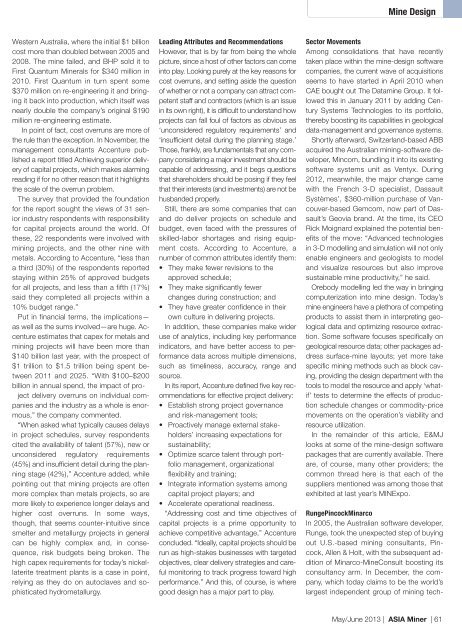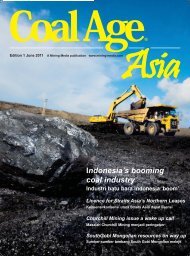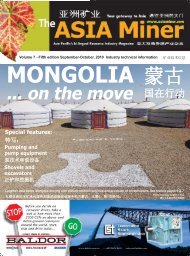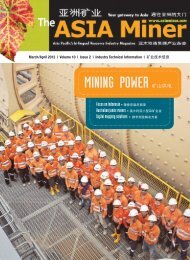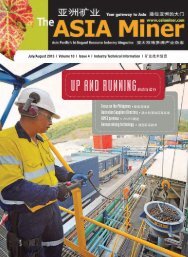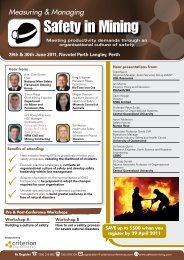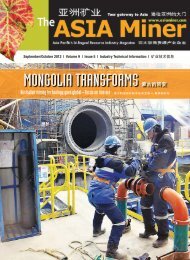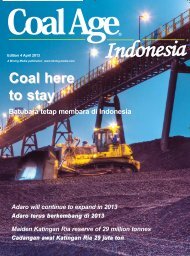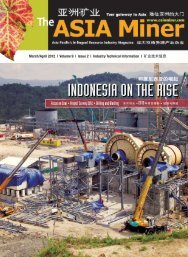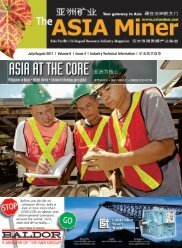May/June 2013 - The ASIA Miner
May/June 2013 - The ASIA Miner
May/June 2013 - The ASIA Miner
You also want an ePaper? Increase the reach of your titles
YUMPU automatically turns print PDFs into web optimized ePapers that Google loves.
Mine Design<br />
Western Australia, where the initial $1 billion<br />
cost more than doubled between 2005 and<br />
2008. <strong>The</strong> mine failed, and BHP sold it to<br />
First Quantum <strong>Miner</strong>als for $340 million in<br />
2010. First Quantum in turn spent some<br />
$370 million on re-engineering it and bringing<br />
it back into production, which itself was<br />
nearly double the company’s original $190<br />
million re-engineering estimate.<br />
In point of fact, cost overruns are more of<br />
the rule than the exception. In November, the<br />
management consultants Accenture published<br />
a report titled Achieving superior delivery<br />
of capital projects, which makes alarming<br />
reading if for no other reason that it highlights<br />
the scale of the overrun problem.<br />
<strong>The</strong> survey that provided the foundation<br />
for the report sought the views of 31 senior<br />
industry respondents with responsibility<br />
for capital projects around the world. Of<br />
these, 22 respondents were involved with<br />
mining projects, and the other nine with<br />
metals. According to Accenture, “less than<br />
a third (30%) of the respondents reported<br />
staying within 25% of approved budgets<br />
for all projects, and less than a fifth (17%)<br />
said they completed all projects within a<br />
10% budget range.”<br />
Put in financial terms, the implications—<br />
as well as the sums involved—are huge. Accenture<br />
estimates that capex for metals and<br />
mining projects will have been more than<br />
$140 billion last year, with the prospect of<br />
$1 trillion to $1.5 trillion being spent between<br />
2011 and 2025. “With $100–$200<br />
billion in annual spend, the impact of project<br />
delivery overruns on individual companies<br />
and the industry as a whole is enormous,”<br />
the company commented.<br />
“When asked what typically causes delays<br />
in project schedules, survey respondents<br />
cited the availability of talent (57%), new or<br />
unconsidered regulatory requirements<br />
(45%) and insufficient detail during the planning<br />
stage (42%),” Accenture added, while<br />
pointing out that mining projects are often<br />
more complex than metals projects, so are<br />
more likely to experience longer delays and<br />
higher cost overruns. In some ways,<br />
though, that seems counter-intuitive since<br />
smelter and metallurgy projects in general<br />
can be highly complex and, in consequence,<br />
risk budgets being broken. <strong>The</strong><br />
high capex requirements for today’s nickellaterite<br />
treatment plants is a case in point,<br />
relying as they do on autoclaves and sophisticated<br />
hydrometallurgy.<br />
Leading Attributes and Recommendations<br />
However, that is by far from being the whole<br />
picture, since a host of other factors can come<br />
into play. Looking purely at the key reasons for<br />
cost overruns, and setting aside the question<br />
of whether or not a company can attract competent<br />
staff and contractors (which is an issue<br />
in its own right), it is difficult to understand how<br />
projects can fall foul of factors as obvious as<br />
‘unconsidered regulatory requirements’ and<br />
‘insufficient detail during the planning stage.’<br />
Those, frankly, are fundamentals that any company<br />
considering a major investment should be<br />
capable of addressing, and it begs questions<br />
that shareholders should be posing if they feel<br />
that their interests (and investments) are not be<br />
husbanded properly.<br />
Still, there are some companies that can<br />
and do deliver projects on schedule and<br />
budget, even faced with the pressures of<br />
skilled-labor shortages and rising equipment<br />
costs. According to Accenture, a<br />
number of common attributes identify them:<br />
• <strong>The</strong>y make fewer revisions to the<br />
approved schedule;<br />
• <strong>The</strong>y make significantly fewer<br />
changes during construction; and<br />
• <strong>The</strong>y have greater confidence in their<br />
own culture in delivering projects.<br />
In addition, these companies make wider<br />
use of analytics, including key performance<br />
indicators, and have better access to performance<br />
data across multiple dimensions,<br />
such as timeliness, accuracy, range and<br />
source.<br />
In its report, Accenture defined five key recommendations<br />
for effective project delivery:<br />
• Establish strong project governance<br />
and risk-management tools;<br />
• Proactively manage external stakeholders’<br />
increasing expectations for<br />
sustainability;<br />
• Optimize scarce talent through portfolio<br />
management, organizational<br />
flexibility and training;<br />
• Integrate information systems among<br />
capital project players; and<br />
• Accelerate operational readiness.<br />
“Addressing cost and time objectives of<br />
capital projects is a prime opportunity to<br />
achieve competitive advantage,” Accenture<br />
concluded. “Ideally, capital projects should be<br />
run as high-stakes businesses with targeted<br />
objectives, clear delivery strategies and careful<br />
monitoring to track progress toward high<br />
performance.” And this, of course, is where<br />
good design has a major part to play.<br />
Sector Movements<br />
Among consolidations that have recently<br />
taken place within the mine-design software<br />
companies, the current wave of acquisitions<br />
seems to have started in April 2010 when<br />
CAE bought out <strong>The</strong> Datamine Group. It followed<br />
this in January 2011 by adding Century<br />
Systems Technologies to its portfolio,<br />
thereby boosting its capabilities in geological<br />
data-management and governance systems.<br />
Shortly afterward, Switzerland-based ABB<br />
acquired the Australian mining-software developer,<br />
Mincom, bundling it into its existing<br />
software systems unit as Ventyx. During<br />
2012, meanwhile, the major change came<br />
with the French 3-D specialist, Dassault<br />
Systèmes’, $360-million purchase of Vancouver-based<br />
Gemcom, now part of Dassault’s<br />
Geovia brand. At the time, its CEO<br />
Rick Moignard explained the potential benefits<br />
of the move: “Advanced technologies<br />
in 3-D modelling and simulation will not only<br />
enable engineers and geologists to model<br />
and visualize resources but also improve<br />
sustainable mine productivity,” he said.<br />
Orebody modelling led the way in bringing<br />
computerization into mine design. Today’s<br />
mine engineers have a plethora of competing<br />
products to assist them in interpreting geological<br />
data and optimizing resource extraction.<br />
Some software focuses specifically on<br />
geological resource data; other packages address<br />
surface-mine layouts; yet more take<br />
specific mining methods such as block caving,<br />
providing the design department with the<br />
tools to model the resource and apply ‘whatif’<br />
tests to determine the effects of production<br />
schedule changes or commodity-price<br />
movements on the operation’s viability and<br />
resource utilization.<br />
In the remainder of this article, E&MJ<br />
looks at some of the mine-design software<br />
packages that are currently available. <strong>The</strong>re<br />
are, of course, many other providers; the<br />
common thread here is that each of the<br />
suppliers mentioned was among those that<br />
exhibited at last year’s MINExpo.<br />
RungePincockMinarco<br />
In 2005, the Australian software developer,<br />
Runge, took the unexpected step of buying<br />
out U.S.-based mining consultants, Pincock,<br />
Allen & Holt, with the subsequent addition<br />
of Minarco-MineConsult boosting its<br />
consultancy arm. In December, the company,<br />
which today claims to be the world’s<br />
largest independent group of mining tech-<br />
<strong>May</strong>/<strong>June</strong> <strong>2013</strong> | <strong>ASIA</strong> <strong>Miner</strong> | 61


